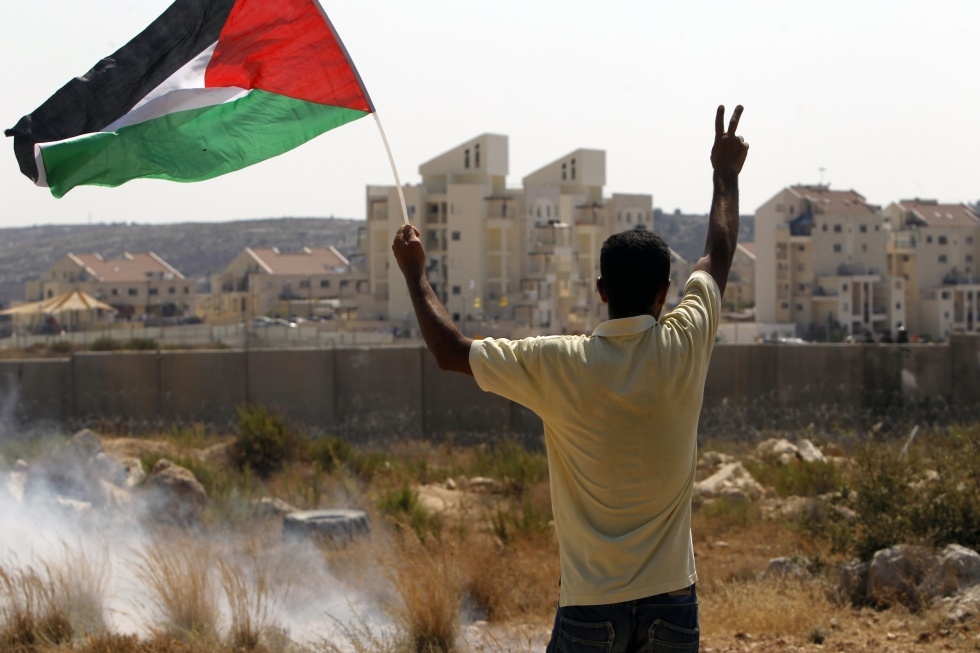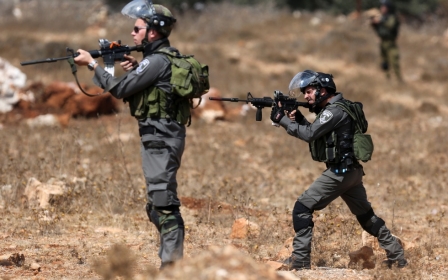Bil’in adds something new to protests

Bil’in, Occupied West Bank: On 9 October, a group of artists and activists, more than two dozen strong, began a two-week “artistic residency” in Bil’in, a village famed for its creative resistance. The group collaborated with the residents of the village in theatre, mural and puppet-making projects.
Bil’in has been the subject of countless articles, radio stories and documentaries for its ten years of weekly protests against the Israeli separation barrier that lines the occupied West Bank.
The barrier, often referred to as the “apartheid wall,” keeps Palestinians from entering present-day Israel, while simultaneously annexing huge swaths of land reserved for Jewish-only settlements.
Many feel that Bil’in has served as the West Bank’s mirror to the outside world, reflecting its struggle. “What is happening in all of the West Bank, the ever increasing settlements, reflects here,” Fidaa Ataya, one of the organisers of the residency, told Middle East Eye.
The agricultural village sits across the barrier from the Israeli settlement of Modi’in Illit. The settlement was built on Palestinian land taken from five villages - Nil’in, Kharbata, Saffa, Dir Qadis and Bil’in.
Abdullah Bitoli, a tour guide originally from Kharbata who now lives in Jerusalem, happened upon the activists painting murals on the main road that connects Bil’in to Ramallah.
“I think it’s great. We need as much international solidarity as possible. We love to share our culture, and the olive harvest is a big part of that,” he said, mentioning the olive crops being picked throughout the area.
For many Palestinians, land is livelihood. The Israeli occupation takes away the opportunities of Palestinians to study where they want, pursue careers, education, travel abroad, or even travel freely from one West Bank city to another.
As a result, farming is a popular occupation, both for the reasons previously listed and a desire to remain close to the resource being stripped of Palestinians on an almost monthly basis.
The protests of Bil’in saved approximately 173 acres of this resource. The separation barrier was rerouted in 2011, thanks to international support and legal action undertaken by the villagers of Bil’in.
Since then, villagers have continued the weekly protests. However, a feeling of protest fatigue has been growing since the wall was rerouted and “Five Broken Cameras,” a documentary that attests to the struggle of Bil’in, earned its director an Oscar nomination for best documentary.
Fame accompanied these successes. The protests, which have cost two residents, siblings Bassem and Jawahar Abu Rahmah, their lives, now draw many “conflict tourists.”
MEE has recently reported on the rise of conflict tourism from Bil’in. “In many places, tourists are attracted not despite of conflict, but because of this conflict,” Dr. Rami Isaac, a senior lecturer and specialist in conflict tourism at the Netherlands’ Breda University, told MEE in May.
The 17 October protest was a prime example of that phenomenon.
Internationals from Europe, the United States and Latin America had all been in attendance from 9-16 October. Hector Aristizabal, a native of Colombia and director of the theatre outreach programme, Imaginaction, and Francisco Letelier, the son of Chilean diplomat, Orland Letelier, who was assassinated in Washington DC by the then-dictator of Chile, Augusto Pinochet, guided the activists and residents in theatre and mural making.
“We are not here to teach people what to do, we’re here to conjure the imagination of the community so that the potential alternatives come from them, not from us,” Aristizabal said, stressing that it was not his intention to do anything other than imagination. “These people know how to handle conflict. What can you do in front of people with weapons? Survive.”
On the morning of the protest, the activists dressed in costumes celebrating the olive harvest and marched with props created for the protest through the streets lined with murals that had been painted over the past week.
Once they reached the traditional starting point of the protests, the numbers of the group ballooned.
Suddenly, a cacophony of languages could be heard. Swedish mixed with German and Japanese as older tourists marched with the group towards the separation barrier.
The Israeli army was waiting on the hilltop. They began firing tear gas and noise bombs at the group. Many of the newcomers stayed at a safe distance, while the activists and protest veterans of Bil’in rushed past two army jeeps.
“Maybe we should head back to the bus soon,” a tourist with a thick German accent said to their tour guide.
The group, armed only with cardboard olive trees, a “teargas monster,” and a sun and moon graced with the faces of the Abu Rahmah siblings made it to the separation barrier. Two of the protestors, including organiser Ataya, were shot with teargas canisters at close range.
The discrepancy between the conflict tourists and those who had been in Bil’in for at least a week and, at most, their entire lives, was glaring.
When asked about the large number of internationals joining their protests for one day only, Ataya had her reservations. “Palestinian life isn’t simple, it isn’t as the outside world sees it,” she said, commenting on the small amount of time these conflict tourists spend in her home. “We don’t need help searching [for] our freedom in this complicated political situation.”
But the invitation to those who had a genuine wish to experience the struggle, and culture, of the Palestinian people was always open. She wants them to come “taste our food” and “to live with us, to really hear [us].”
“As much as we can, we’re looking for people to come to us just to feel the humanity inside of Palestine,” she concluded.
Middle East Eye propose une couverture et une analyse indépendantes et incomparables du Moyen-Orient, de l’Afrique du Nord et d’autres régions du monde. Pour en savoir plus sur la reprise de ce contenu et les frais qui s’appliquent, veuillez remplir ce formulaire [en anglais]. Pour en savoir plus sur MEE, cliquez ici [en anglais].




